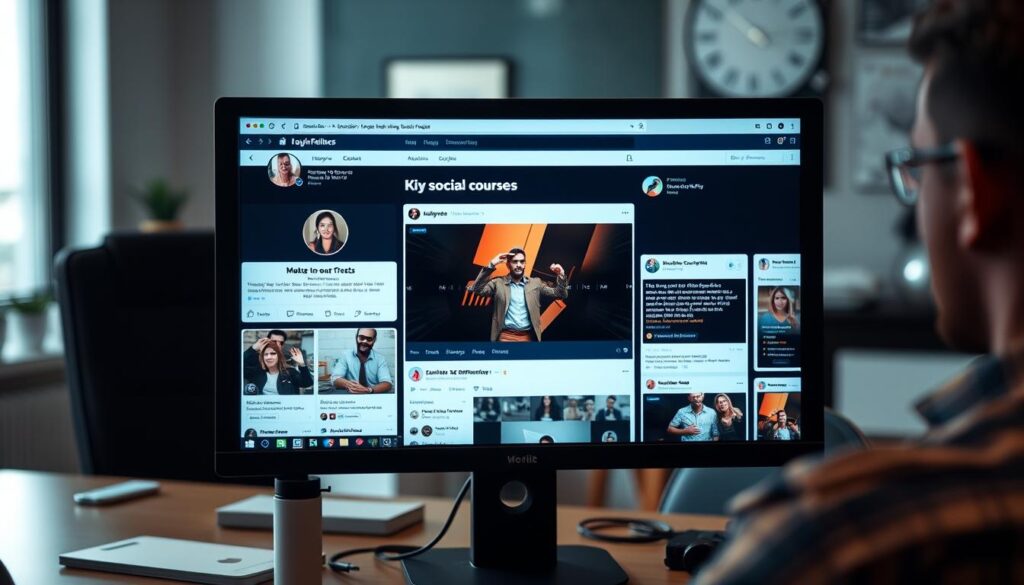In today’s competitive learning landscape, standing out is essential. I’ve discovered that defining a unique identity for your course is the first step to success. Whether you’re teaching beginners or advanced learners, knowing your target audience is key to crafting content that resonates.
Drawing from insights like those of Everest Language School, I’ve seen how platforms like Facebook can drive enrollments effectively. Video content, for example, has become a powerful tool to engage potential students. YouTube, the second most visited search engine, is a prime example of this trend1.
My journey has taught me that matching the right platform to your course type is crucial. Live streaming and engaging posts can spark interest and build trust. By offering free resources like webinars, you can give students a taste of what to expect, increasing their likelihood to enroll1.
Let’s explore how you can elevate your course’s visibility and connect with the right audience. Together, we’ll unlock strategies to make your content stand out.
Key Takeaways
- Define a unique identity for your course to stand out.
- Use video content to engage potential students effectively.
- Match the right platform to your course type for better results.
- Offer free resources like webinars to build trust.
- Focus on your target audience to create resonant content.
Introduction
With billions of users worldwide, digital platforms offer unparalleled opportunities for educators. The way we share knowledge has shifted dramatically, and online learning is now a cornerstone of modern education. Platforms like Facebook and Instagram have become essential tools for reaching a global audience.
However, standing out in this crowded space can be challenging. Many educators struggle to capture attention amidst the noise. Research shows that video content and live sessions significantly boost engagement, making them powerful tools for course promotion2.
One key challenge is choosing the right platform. For example, Instagram is ideal for visual storytelling, while LinkedIn caters to professional development. Understanding your target audience is crucial to making the right choice3.
In this article, I’ll share actionable strategies to help you navigate this dynamic landscape. From leveraging video content to hosting engaging webinars, you’ll discover how to make your course stand out and connect with the right learners.
Defining Your Unique Learning Value
Crafting a standout online learning experience starts with clarity and purpose. To truly connect with learners, you need to identify what makes your course unique. This begins with understanding your unique selling points (USPs) and aligning them with your target audience.
Identifying Your Course USPs
What sets your course apart? Is it the teaching style, the practical applications, or the depth of knowledge? For example, Everest Language School redefined its value proposition by focusing on interactive, real-world language use. This approach resonated with their student base and increased enrollments4.
Research shows that tailored messaging can significantly boost engagement. By highlighting your USPs, you can attract the right learners and build trust5.
Understanding My Student Personas
Knowing your audience is crucial. Are they beginners, professionals, or hobbyists? Creating detailed student personas helps you craft content that speaks directly to their needs. For instance, FutureLearn uses personas to design courses that align with learner expectations4.
Platforms like LinkedIn are particularly effective for reaching professionals, with 78% of training providers leveraging it for course promotion4. By understanding your audience, you can choose the right platform and tailor your messaging for maximum impact.
Understanding Social Media Platforms for Course Promotion
Navigating the digital landscape for educational success requires strategic platform selection. Choosing the right platform can make or break your course promotion efforts. Each platform offers unique features that cater to different audiences and content types.
Matching the Best Platform to My Course
Selecting the right platform depends on your course content and target audience. Instagram, with its visual appeal, is ideal for creative and visually-driven courses. Facebook, on the other hand, thrives on community engagement and is perfect for interactive learning6.
For professional development, LinkedIn is the go-to platform. Its user base consists of professionals seeking to enhance their skills7. Understanding your audience and their preferences is key to making the right choice.
Analyzing Engagement and Reach Trends
Engagement rates vary across platforms. Instagram boasts higher engagement compared to Facebook and Twitter, despite having fewer posts7. This makes it a powerful tool for reaching your target audience.
YouTube and TikTok are excellent for sharing video content. Short-form videos, in particular, have the highest ROI and are highly engaging6. Leveraging these platforms can significantly boost your course visibility.
| Platform | Engagement Rate | Best For |
|---|---|---|
| High | Visual Content | |
| Medium | Community Engagement | |
| High | Professional Development | |
| YouTube | High | Video Content |
| TikTok | Very High | Short-Form Videos |
To maximize your course promotion, it’s essential to analyze engagement and reach trends regularly. Platforms like YouTube and TikTok offer unique opportunities to connect with your audience through dynamic video content6. For more insights on leveraging these platforms, check out our webinar promotion strategies.
Building an Effective Social Media Strategy
A well-structured plan is the backbone of any successful online learning campaign. To ensure your course reaches the right audience, creating a robust content calendar is essential. This approach helps maintain consistency and keeps your strategy on track.
Creating a Robust Content Calendar
My step-by-step approach begins with identifying key academic dates and marketing campaigns. Aligning your content calendar with these events ensures timely and relevant posts. For example, scheduling webinars before enrollment periods can drive interest and engagement8.
Consistency is key. I recommend scheduling posts, videos, and blog updates in advance. This not only saves time but also ensures a steady flow of content. Using analytics tools, I determine the best times to post for maximum reach and engagement9.
Balancing your content is equally important. A mix of promotional, educational, and engaging posts keeps your audience interested. For instance, sharing success stories or testimonials can build trust and encourage enrollments8.
| Content Type | Frequency | Purpose |
|---|---|---|
| Promotional Posts | 2-3 per week | Highlight course benefits |
| Educational Videos | 1 per week | Provide value and insights |
| Webinars | Monthly | Engage and inform |
| Blog Updates | Bi-weekly | Share in-depth knowledge |
Structured planning has proven effective in my experience. By aligning my content calendar with target audience needs, I’ve seen a significant increase in enrollments. For more tips on creating an effective strategy, explore our digital library.
Leveraging Digital Resources and Free Webinars
Free digital resources and webinars have become essential tools for engaging learners and building trust. Offering value upfront helps attract potential students and showcases the quality of your course. By providing free e-books, tutorials, and on-demand webinars, you can create a pipeline of engaged users who are more likely to enroll in paid programs10.
Exploring Top-Notch E-Books and Courses
High-quality e-books and free courses are powerful ways to demonstrate your expertise. These resources give learners a taste of what to expect, helping them make informed decisions. For example, platforms like Everest Language School have successfully used free language guides to drive enrollments10.
Research shows that offering free resources can increase trust and engagement by up to 30%11. By aligning these materials with your target audience’s needs, you can create a strong connection and encourage them to explore your paid offerings.
Promoting FREE Webinars to Elevate Learning
Webinars are a dynamic way to showcase your teaching style and course content. Hosting free sessions allows you to interact directly with your audience and address their questions in real-time. This approach not only builds trust but also generates buzz around your program12.
To maximize attendance, promote your webinars across multiple platforms. For instance, posting on LinkedIn, Facebook, and Instagram can increase registration rates by up to 50%11. Use teaser videos and email campaigns to create excitement and ensure a high turnout.
| Platform | Promotion Strategy | Expected Impact |
|---|---|---|
| Post in relevant groups and use employee networks | High engagement from professionals | |
| Create event pages and share in communities | Broad reach and community interaction | |
| Use Stories and Reels to promote | High visual engagement | |
| Send personalized invitations and reminders | Direct communication with interested users |
After the webinar, follow up with attendees by sharing the recording and additional resources. This keeps the conversation going and increases the likelihood of conversions10. For more insights on leveraging webinars effectively, check out our webinar promotion strategies.
Optimizing Your Social Media Profiles for Courses
Your online presence is the first impression potential students have of your course. A well-optimized profile can significantly boost visibility and credibility. I’ve found that small tweaks in profile details can lead to big improvements in engagement13.

Enhancing Profile Details for Better Visibility
Start by updating your bio to clearly showcase your course offerings and credentials. Include key details like certifications, awards, and unique selling points. For example, Speak Up London Language School highlights its interactive teaching methods, which resonate with their target audience13.
Cover images and profile pictures should reflect your brand’s identity. Use high-quality visuals that align with your course theme. Consistency across platforms like Facebook, Instagram, and LinkedIn builds trust and recognition14.
Linking to your course landing pages is another effective strategy. This not only drives traffic but also provides a seamless experience for potential students. Call-to-action buttons like “Enroll Now” or “Learn More” can further enhance visibility13.
Here are some practical steps to optimize your profile:
- Update your bio with relevant keywords and credentials.
- Use consistent visuals across all platforms.
- Link directly to your course landing pages.
- Add clear call-to-action buttons.
- Regularly review and update your profile to reflect new offerings.
By following these steps, I’ve seen a noticeable increase in engagement and enrollments. For more tips on profile optimization, check out this comprehensive guide.
Remember, a well-optimized profile not only attracts students but also builds trust and authority. Small changes can make a big difference in how your course is perceived14.
Key Strategies in Social Media Promotion for Courses
Effective strategies can transform how your course connects with learners. I’ve found that a balanced mix of organic posts, paid ads, and community engagement works best. For example, using targeted ads based on audience insights can reduce costs by up to 40%15.
Platform-specific adjustments are crucial. On Facebook, posting 1-2 times daily ensures consistent visibility16. Instagram, with its visual appeal, thrives on 3-7 posts weekly. Tailoring your content to each platform maximizes engagement and reach15.
Small-budget paid advertising can yield significant results. I’ve seen campaigns with as little as $0.20 per click on Instagram drive meaningful traffic16. Collaborating with influencers also amplifies your message, especially when their audience aligns with your target learners.
Experimenting with post formats is key. Short-form videos, for instance, have a higher ROI and are highly engaging15. Regularly analyzing performance metrics like click-through rates and conversions helps refine your strategy for better outcomes.
“A well-defined approach can lead to measurable results, such as growing your audience by 50 followers weekly.”
Finally, community engagement fosters trust and loyalty. Responding to comments, hosting live Q&A sessions, and sharing user-generated content creates a sense of belonging. This approach not only attracts students but also retains them17.
By implementing these strategies, I’ve seen a noticeable increase in enrollments and engagement. 🚀 Boost your skills with our digital library! Explore top-notch e-books, courses, and web design resources. Plus, don’t miss our FREE webinars. Elevate your learning today at digitals.anthonydoty.com.
Integrating Video Content and Live Engagements
Video content has become a cornerstone of modern education, offering dynamic ways to engage learners. I’ve found that blending live streaming and short-form clips creates a powerful strategy to connect with my audience. This approach not only showcases course highlights but also builds trust through real-time interaction18.
Utilizing Live Streaming for Real-Time Interaction
Live streaming allows me to interact directly with students, answering questions and addressing concerns in real-time. Platforms like Facebook Live and YouTube have proven effective for this purpose. Live sessions generate six times more interactions than regular videos, making them a valuable tool for engagement19.
I’ve learned that timing is crucial. Hosting live sessions during peak hours ensures maximum participation. Additionally, promoting these events across multiple channels increases attendance and visibility20.
Creating Engaging Short-Form Video Clips
Short-form videos are highly effective in capturing attention. I focus on creating clips that highlight course benefits and student testimonials. Videos under two minutes receive 50% more engagement, making them ideal for quick, impactful messaging19.
Using tools like EdPuzzle, I add interactive elements to my videos. This not only enhances engagement but also supports active learning. Students can pause and rewind, managing their cognitive load more effectively18.
By integrating these strategies, I’ve seen a significant boost in course visibility and enrollments. 🚀 Boost your skills with our digital library! Explore top-notch e-books, courses, and web design resources. Plus, don’t miss our FREE webinars. Elevate your learning today at digitals.anthonydoty.com.
Conclusion
Promoting your course effectively requires a clear strategy and consistent effort. I’ve found that defining a unique identity and understanding your audience are foundational steps. Tailoring your content to resonate with learners can significantly boost engagement and enrollments21.
Integrating video and live interactions has proven to be a game-changer. Platforms like Facebook and YouTube offer dynamic ways to connect with your audience in real-time. This approach not only builds trust but also showcases your expertise22.
Experimenting with different methods is key. Whether it’s short-form clips or interactive webinars, finding what works best for your course can lead to measurable results. Consistency and creativity are essential for long-term success.
🚀 Boost your skills with our digital library! Explore top-notch e-books, courses, and web design resources. Plus, don’t miss our FREE webinars. Elevate your learning today at digitals.anthonydoty.com.
FAQ
How do I identify the unique selling points (USPs) of my course?
Start by listing what makes your course stand out. Think about the skills it teaches, the outcomes it delivers, and how it solves specific problems. Compare it to similar offerings to highlight its uniqueness.
How can I understand my target audience better?
Research your audience’s demographics, interests, and pain points. Use surveys, social media insights, or analytics tools to gather data. This helps tailor your content to their needs.
Which platform is best for promoting my course?
It depends on your audience. LinkedIn works well for professional courses, while Instagram and TikTok are great for visual and creative content. Facebook and YouTube are versatile options for broader reach.
How do I create a content calendar for my strategy?
Plan your posts in advance by mapping out key dates, themes, and topics. Use tools like Trello or Google Calendar to stay organized and consistent with your posting schedule.
What are the benefits of hosting free webinars?
Free webinars attract potential students by offering value upfront. They also position you as an expert and build trust, making it easier to convert attendees into paying customers.
How can I optimize my social media profiles for better visibility?
Use clear, professional images and write a compelling bio that highlights your course. Include relevant keywords and links to your website or landing page to drive traffic.
Why is video content important for course promotion?
Video is engaging and easy to consume. It allows you to showcase your teaching style, share testimonials, and provide sneak peeks of your course content.
How can I use live streaming to interact with my audience?
Host live Q&A sessions, tutorials, or behind-the-scenes looks at your course. This builds a personal connection and encourages real-time engagement.
What are some effective ways to create short-form video clips?
Focus on bite-sized, actionable tips or highlights from your course. Use platforms like Instagram Reels or TikTok to capture attention quickly and drive interest.








